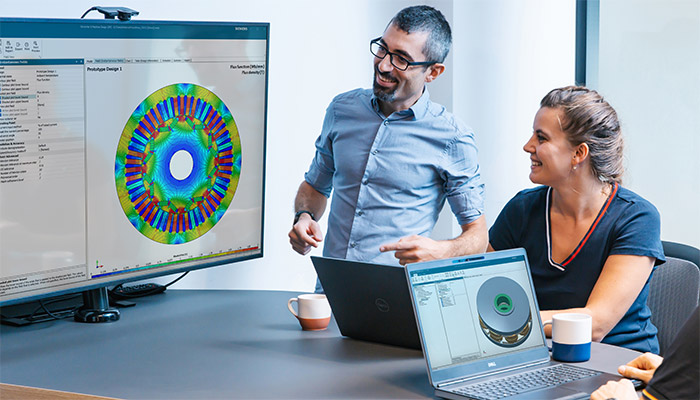Siemens’ new Simcenter™ E-Machine Design software brings together electromagnetic and thermal simulation, helping reduce reliance on physical prototyping and enables the EV industry to accelerate innovation.
New Simcenter E-Machine Design software combines electromagnetic and thermal simulation into a single solution, helps to reduce reliance on physical prototyping and overcome the unique challenges of designing next-generation, compact motors for the electric vehicle industry
Siemens Digital Industries Software announced today its Simcenter™ E-Machine Design software to help electric vehicle (EV) manufacturers and their associated supply chain to accurately predict the performance of e-machines, including axial flux electric drive units. The new solution from the Siemens Xcelerator portfolio of industry software brings together electromagnetic and thermal simulation, helping reduce reliance on physical prototyping and enable the EV industry to accelerate innovation.
“The electric vehicle industry is facing challenges from many directions – supply chain issues, the ability to scale and the pursuit of innovation driven by increasingly demanding customers,” said Jean-Claude Ercolanelli, Senior Vice President, Simulation and Test Solutions, Siemens Digital Industries Software. “By adopting cutting-edge simulation capabilities to develop new products and technologies in shorter timescales than ever achieved, the EV industry can focus on delivering the innovation required to stay relevant in a rapidly changing market.”
Axial flux motors can positively impact the EV range due to their increased power density. Still, engineers adopting them face more challenging heat dissipation requirements (due to their compact size and complexity) and difficulties in accommodating the required air gap. The complex nature of these motors is challenging engineering departments and many are turning to advanced simulation to help reduce development costs and time.
Delivered as part of the latest updates to Siemens’ Simcenter™ software, the new Simcenter E-Machine Design solution allows engineers to use parameterized templates and analytical modeling in the early stages of development, then continue working on their design in 3D with full Finite Element Analysis (FEA) simulations when more complex investigations are required, such as advanced thermal interactions.
Siemens’ new Simcenter™ E-Machine Design software helps electric vehicle (EV) manufacturers and their associated supply chain to accurately predict the performance of e-machines, including axial flux electric drive units (Image credit: Siemens Digital Industries Software)
Other recent updates to Simcenter mechanical simulation tools
Simcenter now includes a simplified electric vehicle powertrain development process, from motor design to Noise, Vibration and Harshness (NVH). Electromagnetic loads from the new Simcenter E-Machine Design software are easily transferred to Simcenter™ 3D software for further acoustics and mechanical motion performance analysis.
The new smart virtual sensing capability empowers test engineers to simulate the unmeasurable. The new tool integrates simulation with physical testing to enable physical test teams to position virtual sensors in critical areas where physical sensors cannot be placed due to location or the complex geometry. This enables measurement of the unmeasurable by using a reduced order model featuring virtual sensors that run in real-time alongside a physical test. It combines data from physical strain gauges with the reduced order model to compute operational loading conditions, which enables engineers to calculate results at the ‘unreachable’ critically located virtual sensor.
Design space exploration is also now fully integrated into Simcenter 3D, enabling the automation of design parameter modification, updating the simulation model, reviewing results and iterating to explore design tradeoffs or achieve an optimal result. The associative integration of CAD geometry, simulation modeling and automation allows the creation of tens, hundreds or more runs without user intervention, helping designers and engineers explore more possibilities for their products.










Be the first to comment on "Siemens brings the power of multi-discipline simulation to axial flux motor development for next-generation EVs"